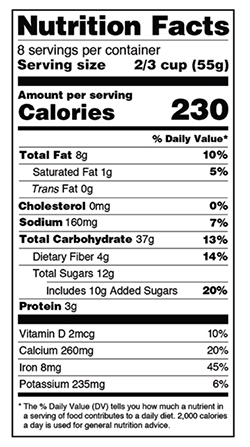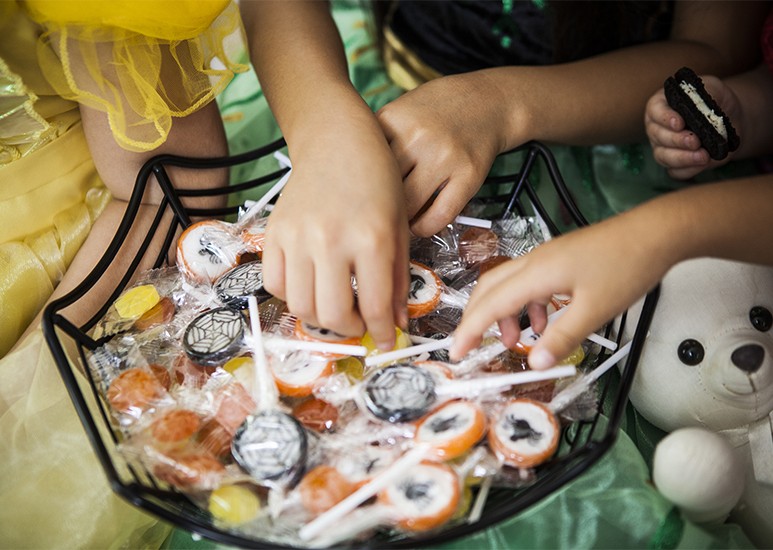Halloween gets a bad reputation for being the jumpstart of the nutritional decline that happens during the holiday season. The truth is, for most Americans, inappropriate intake of sugar starts long before the first trick-or-treaters come knocking.
On average, Americans consume 17 teaspoons of sugar per day. The American Heart Association recommends men should consume no more than 9 teaspoons (36 grams or 150 calories) and women should consume no more than 6 teaspoons (25 grams or 100 calories) per day. Take a moment and consider how sugar intake increases during holiday festivities and you may feel destined for a sweet defeat.
The good news is, with a little awareness, you can begin to see where sugar is lurking and how to prevent unintentional overindulging. Knowledge is power! It all starts with reading the nutrition facts label.
Step 1: Look at Total Sugars
 The nutrition facts label is your new best friend! In May 2016, the label was modified to include “added sugars” for easy reference when choosing better foods. Added sugars in grams, and as % Daily Value, are included on the label. Scientific data shows that it is difficult to meet nutrient needs while staying within calorie limits if you consume more than 10 percent of your total daily calories from added sugar, and this is consistent with the 2020-2025 Dietary Guidelines for Americans.
The nutrition facts label is your new best friend! In May 2016, the label was modified to include “added sugars” for easy reference when choosing better foods. Added sugars in grams, and as % Daily Value, are included on the label. Scientific data shows that it is difficult to meet nutrient needs while staying within calorie limits if you consume more than 10 percent of your total daily calories from added sugar, and this is consistent with the 2020-2025 Dietary Guidelines for Americans.
Step 2: Read the Ingredients Label
It is incredible to think that there are at least 61 different names for added sugar on the ingredients list. The easiest way to know if a product has added sugar is to go back to step 1 and see the grams or % Daily Value the product contains. You may want to familiarize yourself with the wide variety of sugar names so you truly understand where that added sugar is sneaking in.
Other names for sugar:
- Dextrose
- Maltose
- Glucose
- Fructose
- Corn sweetener
- Honey
- Corn syrup
- Sucrose
- Sorghum syrup
- Sorbitol
- Brown sugar
- Lactose
- Molasses
- Syrup
- Fruit juice concentrate
- High-fructose corn syrup
Step 3: Always Be Vigilant
Sugar is hiding in about 75% of foods we see at the grocery store. Some of the top offenders seem innocent until you read that ingredients list! Start label reading on salad dressing, bread, lunch meat, cereal, canned soup, broth, baked goods, and all beverages. You may be surprised what you find!
If you're looking for more tips on how to eat clean, check out our other nutrition articles.
Resources:
Sigman-Grant, M., & Morita, J. (2003, October). Defining and interpreting intakes of sugars. The American Journal of Clinical Nutrition , 78(4), 815S-826S. doi:PMID: 14522745
Food and Drug Administration, U.S. (2012, May 31). Agency Information Collection Activities; Proposed Collection; Comment Request; Experimental Study on Consumer Responses to Nutrition Facts Labels With Various Footnote Formats and Declaration of Amount of Added Sugars. Federal Register , 77, 32120-2.
Ng, S.W., Slining, M.M., & Popkin, B.M. (2012). Use of caloric and noncaloric sweeteners in US consumer packaged foods, 2005-2009. Journal of the Academy of Nutrition and Dietetics , 112(11), 1828-1834.e1821-1826.
Dietary Guidelines for Americans, 2020-2025 and Online Materials | Dietary Guidelines for Americans
How much sugar is too much? | American Heart Association
Added Sugars on the Nutrition Facts Label | FDA

 The nutrition facts label is your new best friend! In May 2016, the label was modified to include “added sugars” for easy reference when choosing better foods. Added sugars in grams, and as % Daily Value, are included on the label. Scientific data shows that it is difficult to meet nutrient needs while staying within calorie limits if you consume more than 10 percent of your total daily calories from added sugar, and this is consistent with the
The nutrition facts label is your new best friend! In May 2016, the label was modified to include “added sugars” for easy reference when choosing better foods. Added sugars in grams, and as % Daily Value, are included on the label. Scientific data shows that it is difficult to meet nutrient needs while staying within calorie limits if you consume more than 10 percent of your total daily calories from added sugar, and this is consistent with the